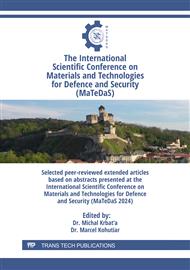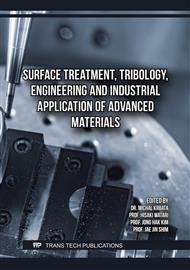[1]
B. Bhushan, B.K. Gupta, Handbook of Tribology: Materials, Coatings, and Surface Treatments, second ed., McGraw-Hill: New York, NY, USA, 1991.
Google Scholar
[2]
P. Horňák, D. Kottfer, L. Kaczmarek, K. Kyziol, J. Vavro, M. Klich, J. Trebuna, M. Vrábeľ, M. Franková, Microstructure and mechanical properties of annealed WCC coatings deposited with different gas mixtures in an RFMS process. Ceram. Silikáty 63 (2019) 213–222.
DOI: 10.13168/cs.2019.0013
Google Scholar
[3]
S. Baragetti, R. Gerosa, B. Rivolta, G. Silva, F. Tordini, Fatigue behavior of foreign object damaged 7075 heat treated aluminum alloy coated with PVD WC/C, Procedia Engineering 10 (2011) 3375–3380.
DOI: 10.1016/j.proeng.2011.04.556
Google Scholar
[4]
L.C. Agudelo-Morimitsu, J. DeLaRoche, A. Ruden, D. Escobar, E. Restrepo-Parra, Effect of substrate temperature on the mechanical and tribological properties of W/WC produced by DC magnetron sputtering, Ceram. Int. 40, (2014) 7037–7042.
DOI: 10.1016/j.ceramint.2013.12.033
Google Scholar
[5]
L.C. Agudelo-Morimitsu, J. DeLaRoche, D. Escobar, R. Ospina, E. Restrepo-Parra. Substrate heating and post-annealing effect on tungsten/tungsten carbide bilayers grown by non-reactive DC magnetron sputtering, Ceram. Int. 39 (2013) 7355–7365.
DOI: 10.1016/j.ceramint.2013.02.075
Google Scholar
[6]
M. Drábik, M. Truchlý, V. Ballo, T. Roch, L. Kvetková, P. Kúš, Influence of substrate material and its plasma pretreatment on adhesion and properties of WC/a-C:H nanocomposite coatings deposited at low temperature, Surf. Coating. Technol. 333 (2018) 138–147.
DOI: 10.1016/j.surfcoat.2017.10.081
Google Scholar
[7]
P. Horňák, D. Kottfer, L. Kaczmarek, M. Kianicová, J. Balko, F. Rehák, M. Pekarčíková, P. Čižnár, The effect of pressure, bias voltage and annealing temperature on N2 and N2+SiH4 doped WC/C DC magnetron sputtered layers, Ceram. Silikáty, 62(1) (2018) 97-107.
DOI: 10.13168/cs.2018.0001
Google Scholar
[8]
M.D. Abad, M.A Muñoz-Márquez, S. El Mrabet, A. Justo, J.C. Sánchez-López, Tailored synthesis of nanostructured WC/a-C layers by dual magnetron sputtering, Surf. Coating. Technol. 204 (2010) 3490–3500.
DOI: 10.1016/j.surfcoat.2010.04.019
Google Scholar
[9]
S. El Mrabet, M.D. Abad, J.C. Sánchez-López, Identification of the wear mechanism on WC/C nanostructured coatings, Surf. Coating. Technol. 206 (2011) 1913–1920.
DOI: 10.1016/j.surfcoat.2011.07.059
Google Scholar
[10]
Y. S. Park, Y. Park, H. Jung, T.-H. Jung, D.-G. Lim, W. S. Choi, Tribological properties of a-C:W film deposited by radio frequency magnetron Co-sputtering method, Thin Solid Films, 521 (2012) 107–111.
DOI: 10.1016/j.tsf.2012.02.042
Google Scholar
[11]
M. Makowka, W. Pawlak, P. Konarski, B. Wendler, Hydrogen content influence on tribological properties of nc-WC/a-C:H coatings, Diam. Relat. Mater. 67 (2016) 16–25.
DOI: 10.1016/j.diamond.2016.01.007
Google Scholar
[12]
H. Zhao, Z. Ni, F. Ye, Effect of carbon content on structure and properties of WCN coatings prepared by RF magnetron sputtering, Surf. Coating. Technol. 287 (2016) 129–137.
DOI: 10.1016/j.surfcoat.2016.01.003
Google Scholar
[13]
Y. Li, A. Zhang, G. Li, The influence of micrstructure on mechanical property of polytypic TiC/ WC nanomultilayers, Vacuum 117 (2015) 23-26.
DOI: 10.1016/j.vacuum.2015.03.027
Google Scholar
[14]
M. Ferdinandy, F. Lofaj, J. Dusza, D. Kottfer, Preparation of WC coatings by W(CO)6 decomposition using PE CVD method (in Slovak). Chem. Lett. 105 (2011) s. 442–s444.
Google Scholar
[15]
M. Trebuňová, D. Kottfer, K. Kyziol, M. Kaňuchová, D. Medved', R. Džunda, M. Kianicová, L. Rusinko, A. Breznická, M. Csatáryová, The WC and CrC Coatings Deposited from Carbonyls Using PE CVD Method—Structure and Properties. Materials, 16 20235044.
DOI: 10.3390/ma16145044
Google Scholar
[16]
F. Lofaj, L. Kvetková, P. Hviščová, M. Gregor, M. Ferdinandy, Reactive processes in the high target utilization sputtering (HiTUS) W–C based coatings, J. Eur. Ceram. Soc. 36 (2016) 3029–3040.
DOI: 10.1016/j.jeurceramsoc.2015.12.043
Google Scholar
[17]
F. Lofaj, M. Kabátová, M. Klich, D. Vaňa, J. Dobrovodský, The comparison of structure and properties in DC magnetron sputtered and HiPIMS W-C:H coatings with different hydrogen content. Ceram. Int. 45 (2019) 9502–9514.
DOI: 10.1016/j.ceramint.2018.09.219
Google Scholar
[18]
F. Lofaj, M. Kabatova, L. Kvetkova, J. Dobrovodsky, V. Girman, Hybrid PVD-PECVD W-C:H coatings prepared by different sputtering techniques: The comparison of deposition processes, composition and properties, Surf. Coating. Technol. 375 (2019) 839–853.
DOI: 10.1016/j.surfcoat.2019.07.078
Google Scholar
[19]
VDI 3198, ASTM C1624 – 05 (2010), Standard Test Method for Adhesion Strength and Mechanical Failure Modes of Ceramic Coatings by Quantitative Single Point Scratch Testing. West Conshohocken, PA, 2010, [Online], Available: http://www.astm.org/Standards/C1624. htm [4 May 2023], 2010.
DOI: 10.1520/c1624
Google Scholar



